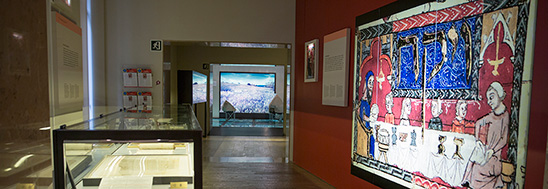
The Jewries: urban areas

In this room we leave behind the private lives and everyday existence of the community to take a bird's eye view of Catalonia's Jewish quarters. The Jewries formed special districts of various cities in medieval Catalonia. The alleys, dwellings, workshops and other workplaces (bakeries and slaughterhouses), shops and ritual buildings (synagogue and baths) provided the framework within which Jewish life could proceed in medieval Catalonia.
Outstanding items

Mikveh (ritual bath)
The remains of the mikveh (ritual bath) used by the Jewish community of Girona between 1435 and 1492 are on the second floor, at the other end of the courtyard. They have been discovered in the course of the archaeological excavations in February 2014, around the area of the old cistern. It is a small sized mikveh fed by rainwater, which entered through a pipe discovered during the excavations.

Model of the Jewish quarter in Girona
In this model we can see the boundaries of the Jewish Quarter in Girona as they were in the late 14th century. The outer limits of the Jewry changed over time, and after the attacks that occurred in 1391 the so-called ôreduced Jewryö was established, a much smaller area which was still expected to give house and home to all the Jewish families in the city.
© 2026 Patronat Call de Girona | Contact | Accessibility
